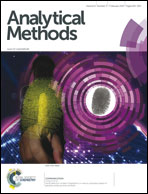Development and multi-laboratory verification of U.S. EPA method 540 for the analysis of drinking water contaminants by solid phase extraction-LC/MS/MS†
Abstract
A drinking water method for 12 chemicals, predominantly pesticides, is presented that addresses the occurrence monitoring needs of the U.S. Environmental Protection Agency (EPA) for a future Unregulated Contaminant Monitoring Regulation (UCMR). The method employs solid phase extraction liquid chromatography/tandem mass spectrometry (SPE-LC/MS/MS). The method uses Trizma, 2-chloroacetamide, and L-ascorbic acid to buffer and preserve the drinking water samples to a maximum of 28 days. Chlorpyrifos oxon is restricted to a holding time of 7 days based on experimental data. Mean recoveries from chlorinated ground water samples fortified (n = 4) with the method analytes at 12.8–32 ng L−1 are 72.0–109% with <6.5% relative standard deviation. Single laboratory lowest concentration minimum reporting levels of 0.30–2.7 ng L−1 are demonstrated with this methodology. Multi-laboratory data are presented that demonstrate method ruggedness and transferability for the method analytes. EPA Method 540 meets all of the UCMR survey requirements for sample collection and storage, precision, accuracy, and sensitivity and may be proposed for use under a future UCMR.


 Please wait while we load your content...
Please wait while we load your content...